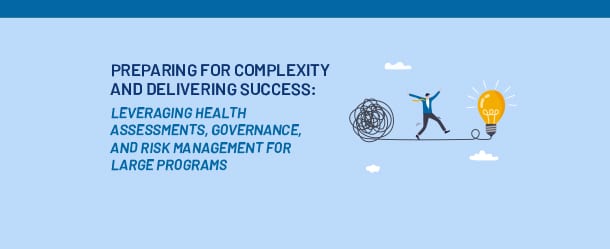



Complexity is the norm rather than the exception for large construction programs. These programs are typically high-profile, marked by significant costs, long timelines, and numerous stakeholders. They may also require complex procurement methods or carry national or institutional importance.
Organizations that manage programs like these are often well poised to do so. They have the resources needed to execute them and the processes to support them. But for most organizations, these programs come around infrequently, and managing them can be a struggle. They find themselves managing reactively, making decisions on the fly, or relying on processes or bureaucracy that can slow them down.
Before launching headlong into these programs, it is important first to acknowledge their complexity and candidly assess your organization’s readiness to take them on. Under its Engineering and Construction Bulletin No. 2023-11, the US Army Corps of Engineers (USACE) has implemented a formal process for identifying its largest programs and assigning them a quantitative Project Complexity Score. By rating its programs from Traditional to Moderately to Highly Complex, USACE can identify the tools and systems needed to manage challenging programs and its teams’ readiness to take them on. At MBP, we call this initial step the “Health Assessment.”
The need to assess the health of a construction program is not much different than the reason we all need to keep up with our regular medical check-ups. Just as a doctor examines a patient for signs of potential issues, a program health assessment involves examining the program’s structure, systems, and staff to identify potential risks or inefficiencies early on before they negatively affect the program.
Health assessments are a vital tool in determining an organization’s readiness to undertake a large-scale construction program. These assessments evaluate the organization’s capabilities and capacity to manage the program and provide a benchmark for the program against industry standards, offering a clear understanding of where the organization stands.
MBP works with stakeholders to evaluate the current state of program governance, design management, cost and finance management, schedule management, risk management, procurement, construction operations, and transition to operations. These areas are critical to the program’s success, and assessing them early allows the organization to pinpoint strengths and weaknesses and address any identified gaps.
Even once the systems and staff are in place to manage a large program effectively, that won’t be enough to deal with the complexities ahead. Clearly defined program governance will be essential to communicating the program’s vision, inspiring the team to achieve program objectives, and making tough and timely decisions.
Effective governance is crucial for managing the complexities of large-scale construction programs. Governance structures establish the framework within which decisions are made, risks are managed, and progress is monitored. Without strong governance, organizations may experience delays and cost overruns.
Governance also ensures that all stakeholders, including multiple designers, contractors, and institutional partners, are aligned with the program’s objectives. This alignment is particularly important in complex programs that require the coordination of overlapping and dependent project phases. A well-defined governance structure facilitates collaboration, reduces misunderstandings, and helps keep the program on track.
The Naval Facilities Engineering Systems Command (NAVFAC) has recognized the critical importance of formal governance. It mandates a multi-tiered governance structure to drive expeditious resolution of issues at the most appropriate level in the program team (NAVFAC Instruction 11013.40B). Beyond issue resolution, leaders at the senior and executive tiers ensure programs have efficient processes in place, promote lessons learned and continuous improvement, encourage the team to adopt a forward-looking risk posture, and require monitoring of key performance indicators (KPI).
A robust governance framework will also include detailed program management plans, clearly defined roles and responsibilities, and established communication channels among all stakeholders. By fostering collaboration and accountability, governance structures enable organizations to make timely decisions and effectively manage the program’s complexities.
With a health assessment completed and program governance in place, there is one last component to managing complexity: risk management.
Risk is an inherent part of any construction program. Whether it’s unforeseen site conditions, supply chain disruptions, or regulatory changes, the potential for challenges is always present. However, the key to managing these risks lies in anticipation and preparation.
This makes risk management perhaps the most critical component of managing complexity in large-scale construction programs. Effective risk management involves a formal process of identifying potential risks early, assessing their impact, and developing strategies to mitigate them.
For the Federal Transit Administration, risk management is a requirement for the receipt of federal funds (Project Management Oversight Procedure 40, Risk and Contingency Review). The FTA expects that major programs improve “the reliability of project delivery” by developing and implementing a Risk and Contingency Management Plan (RCMP). Under the RCMP, a program team is expected to identify uncertainties and risks, assess their impact on cost and schedule, develop mitigation strategies, assign appropriate cost and schedule contingencies, and actively manage risks throughout.
In a comprehensive risk management approach, organizations anticipate and manage risk and change proactively. They continuously assess and monitor program risks throughout the project lifecycle. Regularly evaluating performance against KPIs helps identify trends and emerging risks, allowing organizations to make informed decisions and course correct as needed.
Large-scale construction programs are inherently complex and challenging, but organizations can better prepare themselves for success by focusing on proactive measures. Through health assessments, governance, and risk management, organizations can navigate the complexities of large-scale construction programs with greater confidence, leading to successful outcomes that meet their operational goals and objectives.
These strategic approaches not only enhance the organization’s ability to manage large programs effectively but also provide the tools for success on future programs.
Comments